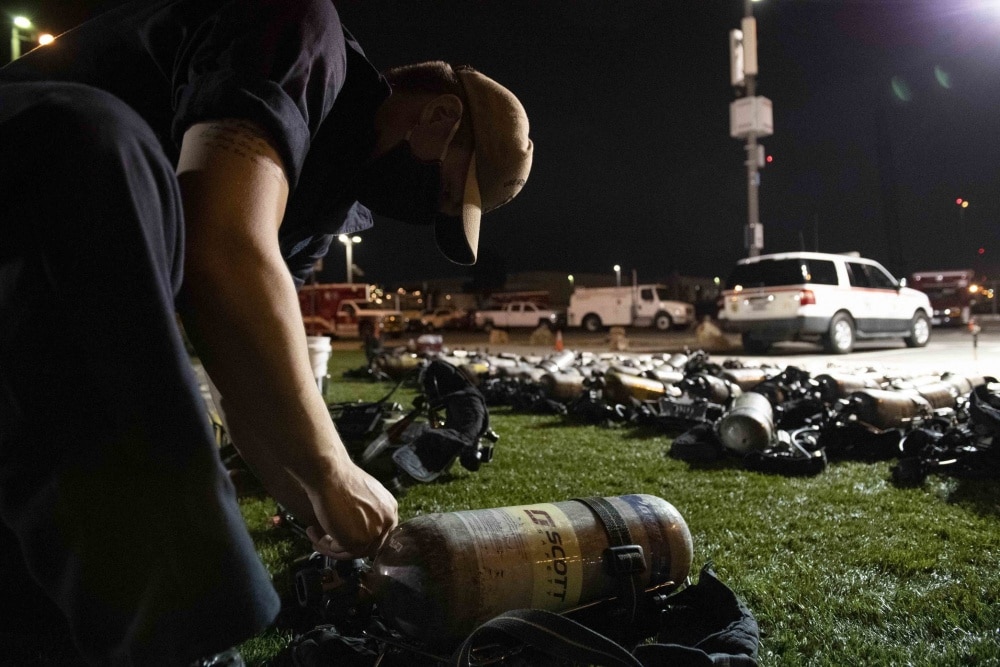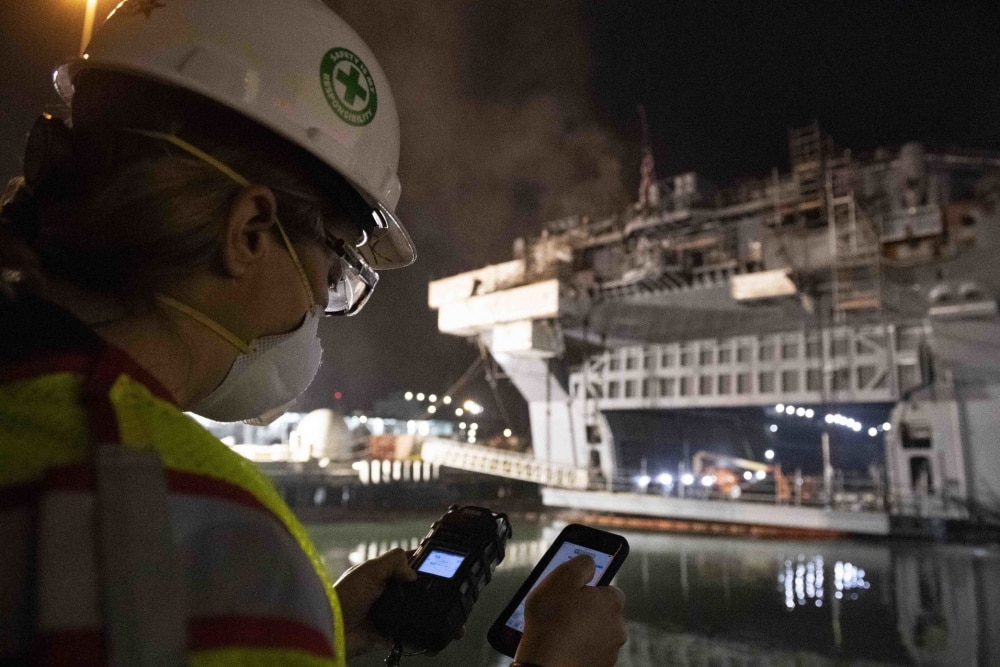Firefighters entered the third day of battling flames and smoke onboard the USS Bonhomme Richard on Tuesday morning after the ship caught fire on Sunday while docked at Naval Base San Diego, Calif.
Video taken Tuesday morning showed firefighting crews, including helicopter water drops, still fighting the fire.
The fire began around 8:30 a.m. PST Sunday after an explosion was reported on the Wasp-class amphibious assault ship docked at Naval Base San Diego. Initial reports indicated 18 personnel were hospitalized with minor injuries and around 160 personnel in total were evacuated from the ship, but by Monday afternoon the U.S. Navy said 59 had been injured.
“As of 3:30 p.m. Pacific time July 13, firefighting teams continue operations on board @LHD6BHR. 59 personnel, 36 @USNavy Sailors and 23 civilians, have been treated for minor injuries including heat exhaustion and smoke inhalation. Currently, there are no personnel hospitalized,” the Twitter account of Naval Surface Forces, U.S. Pacific Fleet tweeted Monday night.
As of 3:30 p.m. Pacific time July 13, firefighting teams continue operations on board @LHD6BHR. 59 personnel, 36 @USNavy Sailors and 23 civilians, have been treated for minor injuries including heat exhaustion and smoke inhalation. Currently, there are no personnel hospitalized. pic.twitter.com/P8SLgEJEyQ
— Naval Surface Forces (@SurfaceWarriors) July 13, 2020
“In the past 48 hours, Federal Fire Department San Diego and U.S. Navy Sailors have conducted numerous firefighting operations, making significant progress with the help of aerial firefighting operations conducted by U.S. Navy helicopters,” Naval Surface Forces tweeted Tuesday morning.
In the past 48 hours, Federal Fire Department San Diego and U.S. Navy Sailors have conducted numerous firefighting operations, making significant progress with the help of aerial firefighting operations conducted by U.S. Navy helicopters. pic.twitter.com/VPdDwzc44f
— Naval Surface Forces (@SurfaceWarriors) July 14, 2020
The U.S. Navy released photos of the firefighting efforts, which continued through the early morning hours Tuesday.

A helicopter from Helicopter Sea Combat Squadron (HSC) 3 combats a fire aboard the amphibious assault ship USS Bonhomme Richard (LHD 6) at Naval Base San Diego, July 14. (U.S. Navy photo by Mass Communication Specialist 3rd Class Garrett LaBarge/Released)

Operations Specialist Seaman Adrian Talbo, a Sailor assigned to the amphibious assault ship USS Bonhomme Richard (LHD 6), organizes self-contained breathing apparatus to distribute to Sailors fighting the fire on the Bonhomme Richard at Naval Base San Diego, July 14. (U.S. Navy photo by Mass Communication Specialist 3rd Class Garrett LaBarge/Released)

Lee Ann Ritterpusch, an industrial hygienist at South West Regional Maintenance Center, evaluates smoke plume and atmospheric levels pierside of the the amphibious assault ship USS Bonhomme Richard (LHD 6) at Naval Base San Diego, July 14. (U.S. Navy photo by Mass Communication Specialist 3rd Class Garrett LaBarge/Released)
On Tuesday, photos began to circulate, showing the extent of the damage in some areas of the ship. In one photo taken from a helicopter, holes could be seen in the deck of the ship.
“USS Bonhomme Richard (LHD 6) 14.07.202,” a Twitter user posted.
USS Bonhomme Richard (LHD 6) 14.07.2020 pic.twitter.com/ZedcQEabjj
— The Dead District (@TheDeadDistrict) July 14, 2020
Other photos showed firefighters entering the parts of the ship, including the upper vehicle stowage area.
“Upper vehicle stowage area of the USS Bonhomme Richard,” a Twitter user posted.
Upper vehicle stowage area of the USS Bonhomme Richard pic.twitter.com/809ugbBcO7
— OSINTtechnical (@Osinttechnical) July 14, 2020
Further reports on Tuesday indicated the ship was beginning to list to one side under the weight of all the water being dropped onto the ship. CBS 8 San Diego reported more than 400 helicopter water drops had flown over the ship.
In a Sunday press conference, Rear Adm. Philip Sobeck said the fire began in the lower vehicle storage area of the ship. On Monday, he said the upper deck continued to burn, the forward mast had collapsed, and the ship was listing.
Despite the damage, Sobeck said firefighters were making “every effort to save that ship.”
In comments to The Hill, Sobeck said the fire suppression system for the USS Bonhomme Richard had been turned off while the ship was undergoing maintenance in port. The shipboard fire suppression system uses Halon, a liquefied compressed gas used. The gas system is preferred as it leaves no residue and doesn’t pose a risk of damaging onboard electrical equipment.



